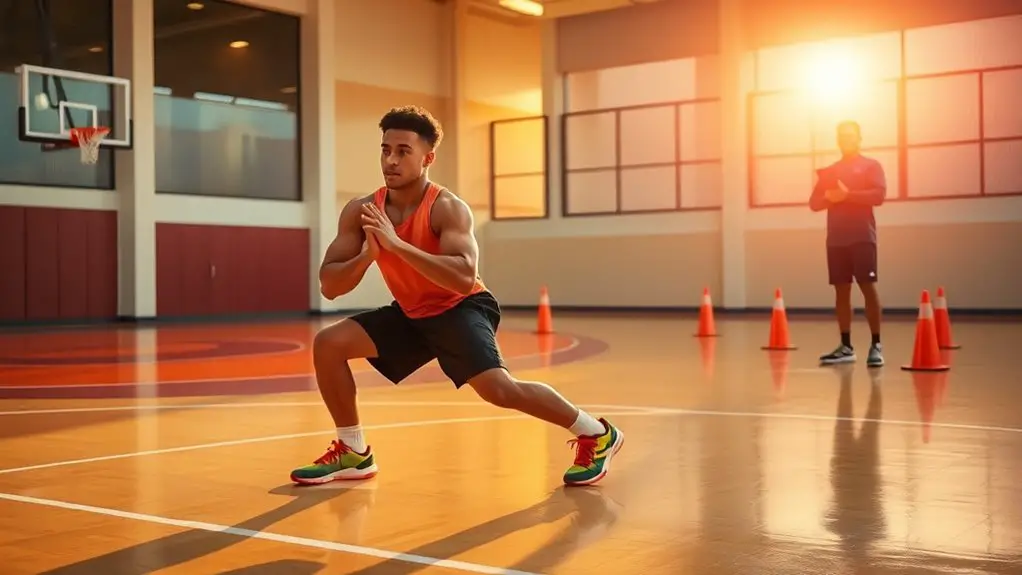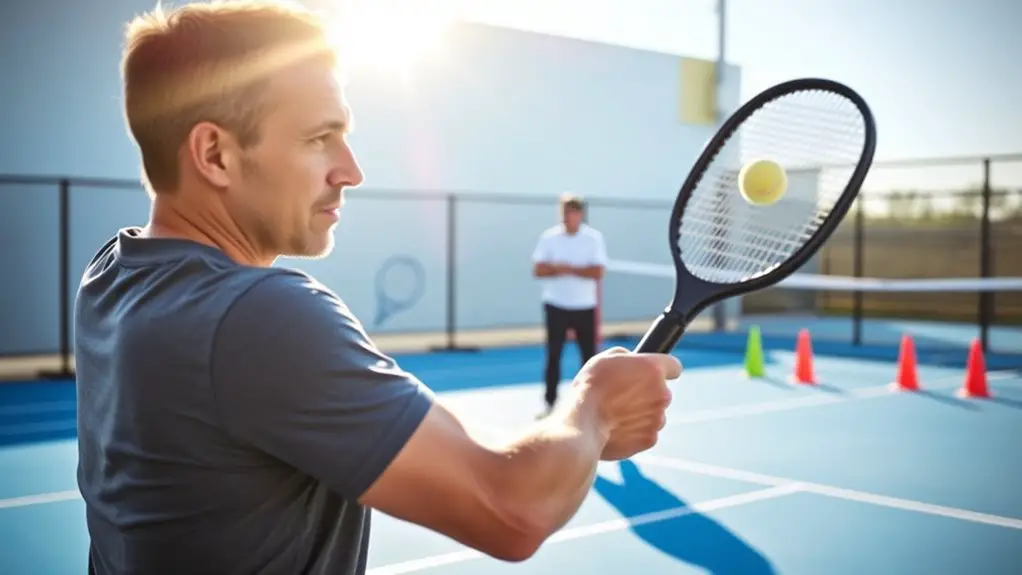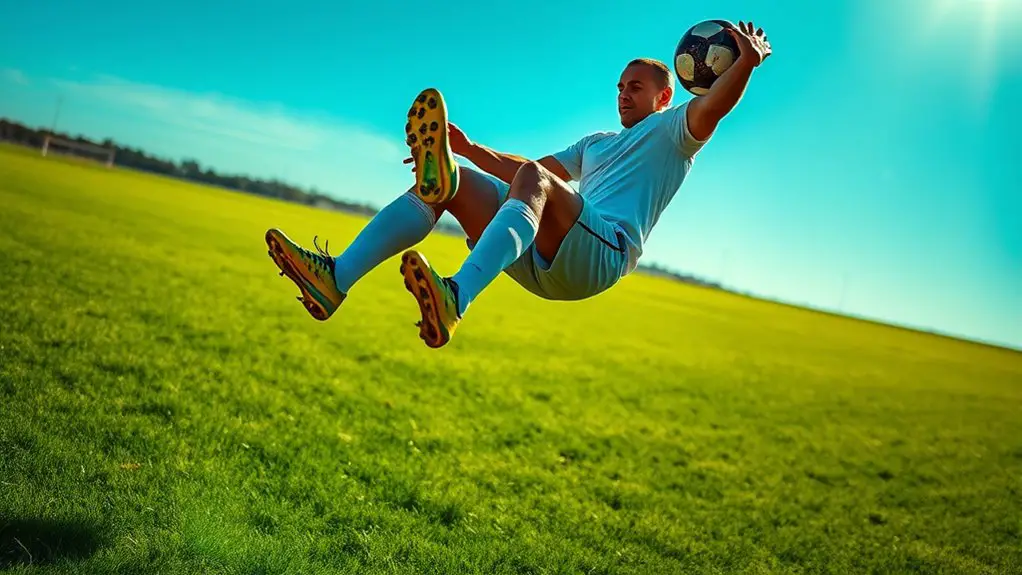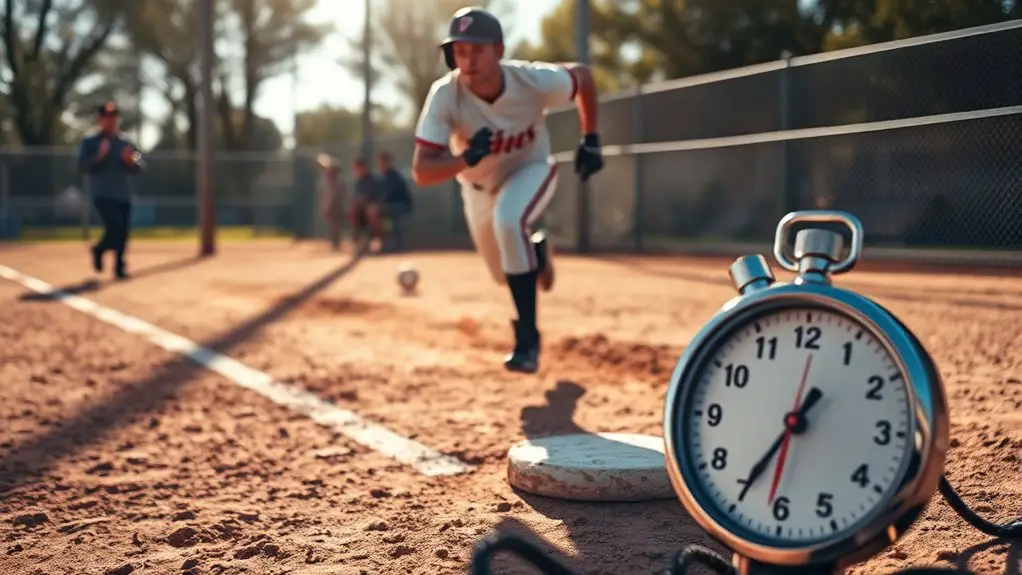To boost your court movement, include dynamic warm-ups like high knees and leg swings to activate muscles and enhance flexibility. Don't forget hip mobility drills, like hip circles and leg swings, to improve agility. Incorporating ankle flexibility techniques, such as ankle circles and foam rolling, is essential for stability. Finally, strengthen your core with planks and rotational exercises for better control. If you want to discover even more effective strategies, keep exploring mobility exercises.
Dynamic Warm-Up Exercises
Dynamic warm-up exercises are essential for preparing your body for court movement. They help activate your muscles and improve your flexibility, allowing for smooth shifts during play. When you engage in dynamic stretches, you're not just loosening up; you're also setting your body up for success by mimicking the movement patterns you'll use in the game.
Think about incorporating movements like high knees, leg swings, and arm circles. These exercises raise your heart rate and increase blood flow, making your muscles more pliable. Incorporating agility training techniques enhances your overall performance and prepares your body for the demands of the game. Feeling free and agile on the court starts with these warm-ups. They not only enhance your performance but also reduce the risk of injury by ensuring your body is ready to handle quick pivots and sprints. So, before you hit the court, take the time to perform a thorough dynamic warm-up. Your body will thank you for it!
Hip Mobility Drills
After a solid warm-up, focusing on hip mobility drills can take your court performance to the next level. These exercises free up your hips, allowing for quicker, more agile movements during play. Start with hip circles; stand on one leg and swing the other leg in a circular motion. This drill not only enhances flexibility but also improves balance. Aim for 10 circles in each direction.
Next, incorporate leg swings. Stand next to a wall for support and swing one leg forward and backward, keeping your core engaged. This helps loosen tight hip flexors and strengthens the surrounding muscles. Perform 10 swings on each leg, and feel the freedom of movement it brings.
Integrating these hip mobility drills into your routine will enhance your agility and overall performance on the court, allowing you to move freely and confidently. Additionally, improved range of motion through consistent mobility training can significantly reduce your risk of injury and enhance your athletic experience.
Ankle Flexibility Techniques
To elevate your court performance, it's essential to incorporate ankle flexibility techniques into your routine. Start with ankle circles; they're simple yet effective. While seated or standing, lift one foot and rotate your ankle in both clockwise and counterclockwise directions. Aim for 10-15 circles on each side to loosen up those joints.
Next, consider foam rolling your calves and ankles. Use a foam roller to gently massage the muscles around your ankles. This'll help release any tightness and improve your overall mobility. Roll for about 1-2 minutes on each side, focusing on areas that feel particularly tight.
Incorporating these techniques will not only enhance your range of motion but also boost your agility on the court, as proper footwork is crucial for maintaining balance and stability during gameplay. You'll feel more free and ready to make those quick movements, giving you the edge you need during gameplay. So, get rolling and start circling—your ankles will thank you!
Core Stability Exercises
While you might focus on your legs and ankles for court movement, core stability is equally essential for maintaining balance and control during play. Your core strength is the backbone of every athletic movement, influencing your ability to pivot, sprint, and change direction seamlessly. By developing a strong core, you'll not only enhance your performance but also reduce the risk of injury. A strong core also prevents injuries by supporting the spine during exertion.
To start, try exercises like planks and bird-dogs, which promote pelvic alignment and engage multiple muscle groups. Incorporating rotational movements, such as medicine ball twists, can also improve your agility on the court. Remember, it's all about finding that sweet spot where strength meets flexibility.
Focusing on these core stability exercises will empower you to move freely and confidently, allowing you to express your full potential in every game. So, embrace the journey of building a solid core—it's your foundation for success!
Cool Down and Stretching Routines
Cooling down and incorporating stretching routines are essential components of any training regimen, especially after intense court activities. These practices not only enhance muscle recovery but also promote flexibility and prevent injuries. As you wind down, take a moment to focus on your breathing techniques—slow, deep breaths can help lower your heart rate and calm your mind.
Start with gentle stretches targeting major muscle groups, like your hamstrings, quads, and shoulders. Hold each stretch for 20-30 seconds, allowing your body to release tension. You might also consider incorporating yoga poses, which can further aid in recovery while promoting freedom of movement. Additionally, remember to stay mindful of hydration after workout, as it plays a crucial role in supporting muscle repair and overall recovery.
Frequently Asked Questions
How Often Should I Perform These Mobility Exercises?
You should aim to incorporate mobility exercises into your daily routine, ideally performing them at least three to five times a week. Consistency is key, so find a schedule that works for you and stick to it. If you can, even a short session daily can make a big difference. Listen to your body, and adjust the exercise frequency as needed to guarantee you're feeling free and flexible in your movements.
Can Mobility Exercises Prevent Injuries During Games?
Yes, mobility exercises can definitely help with injury prevention during games. By improving your flexibility and range of motion, you're reducing the risk of strains and sprains. Plus, better mobility can enhance your game performance, allowing you to move more fluidly and react quicker on the court. So, if you want to stay injury-free and play at your best, incorporating these exercises into your routine is a smart move.
What Equipment Do I Need for These Exercises?
Imagine a bird stretching its wings, ready to soar through the sky. To achieve that freedom in your movements, you'll need some key equipment. Resistance bands are like the wind beneath your wings, helping you build strength and flexibility. A foam roller acts as a gentle cloud, easing muscle tension and promoting recovery. With these tools in hand, you can embrace the freedom of movement, allowing your body to dance across the court with grace.
Are There Age-Specific Modifications for These Exercises?
Absolutely, there are age-specific modifications to take into account. For younger individuals, you can focus on youth adaptations that emphasize flexibility and fun, ensuring they enjoy the process. As you age, it's vital to incorporate more joint-friendly movements, acknowledging any limitations. Adjust the intensity and duration based on your comfort level. By tailoring these exercises to your age, you'll enhance your mobility while staying free to move with confidence and ease.
How Long Will It Take to See Improvements?
It's tough to say exactly how long it'll take to see improvements, as individual variability plays a big role. Generally, you might start noticing progress within a few weeks of consistent practice. To keep yourself motivated, consider tracking your progress—this can really help you stay focused and excited about your journey. Remember, everyone's body responds differently, so stay patient and enjoy the freedom that comes with each step you take!




